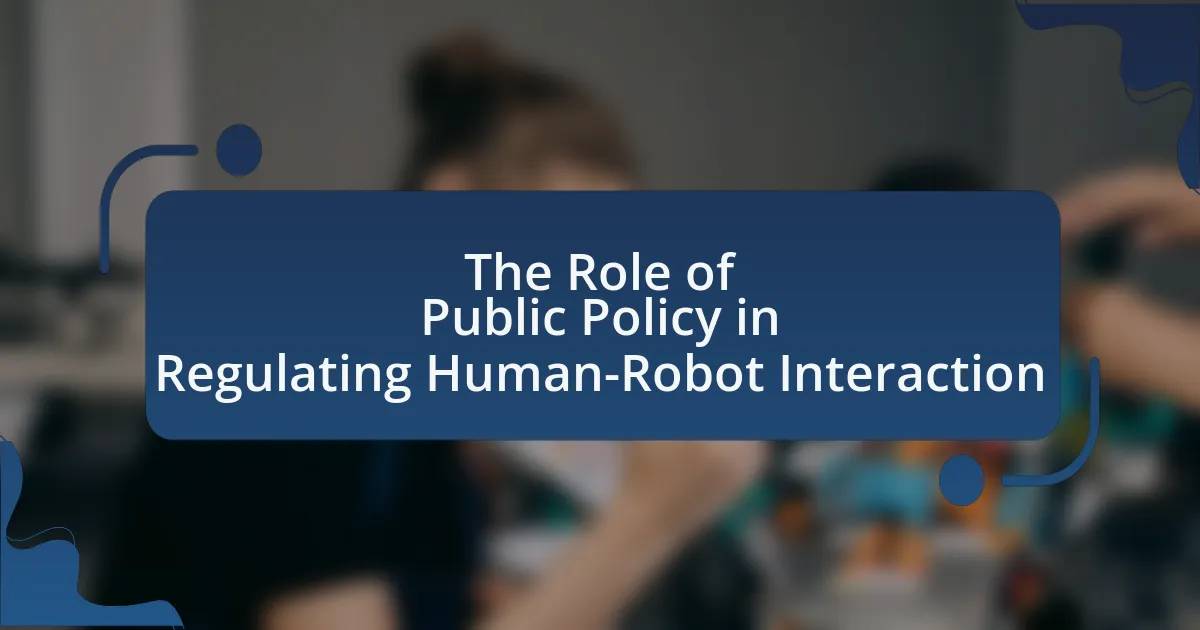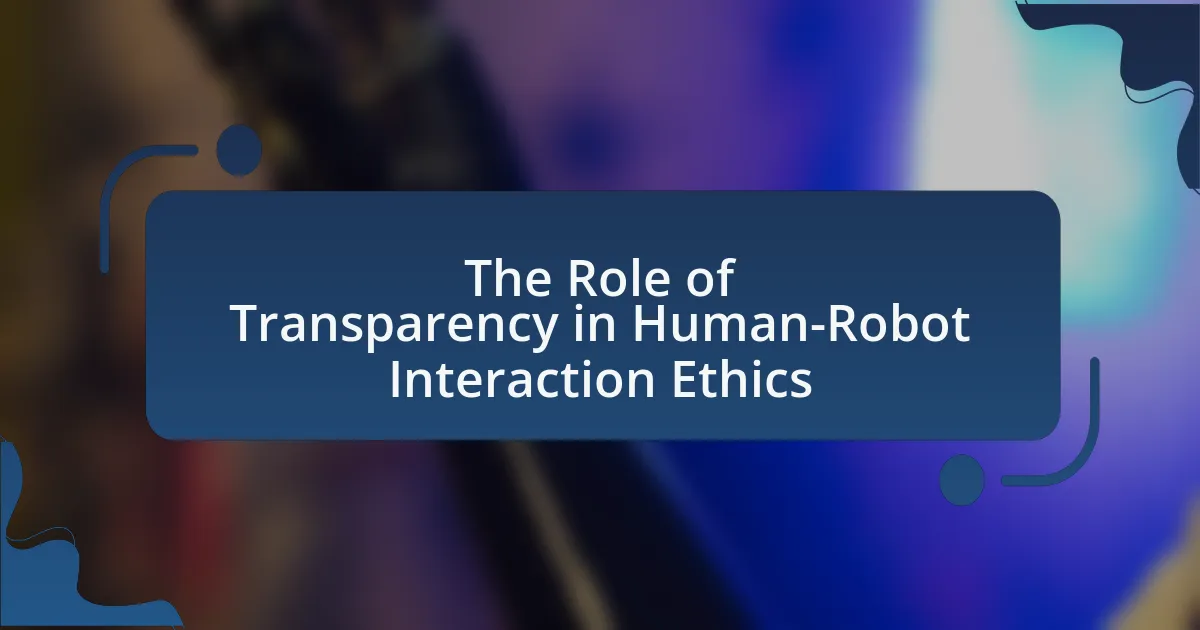The article examines the ethical implications of autonomous decision-making in robots, focusing on accountability, bias, and potential harm. It highlights the complexities that arise in traditional ethical frameworks when robots operate independently, raising questions about liability and moral agency. Key ethical theories relevant to this discussion include utilitarianism, deontology, and virtue ethics, which provide a foundation for addressing the challenges posed by autonomous systems. Additionally, the article explores the societal implications of these technologies, including their impact on employment, privacy, and surveillance, while emphasizing the importance of ethical guidelines and stakeholder involvement in promoting responsible robotics.

What are the Ethical Implications of Autonomous Decision-Making in Robots?
The ethical implications of autonomous decision-making in robots include accountability, bias, and the potential for harm. Accountability arises because it is unclear who is responsible for a robot’s actions—whether it is the manufacturer, programmer, or the robot itself. For instance, in the case of autonomous vehicles, if an accident occurs, determining liability can be complex. Bias is another significant concern, as algorithms may reflect the prejudices of their creators, leading to unfair treatment of certain groups. Research by the AI Now Institute highlights that biased data can result in discriminatory outcomes in automated systems. Lastly, the potential for harm is critical; robots making life-and-death decisions, such as in military applications or healthcare, raises questions about moral agency and the value of human life. These implications necessitate careful consideration and regulation to ensure ethical standards are upheld in the development and deployment of autonomous robots.
How does autonomous decision-making in robots challenge traditional ethical frameworks?
Autonomous decision-making in robots challenges traditional ethical frameworks by introducing complexities in accountability and moral agency. Traditional ethical frameworks, such as deontology and utilitarianism, rely on human decision-makers who can be held accountable for their actions. However, when robots make decisions independently, it becomes unclear who is responsible for the outcomes, complicating the application of these ethical theories. For instance, in scenarios involving autonomous vehicles, if a car makes a decision that results in an accident, determining liability—whether it lies with the manufacturer, the software developer, or the vehicle owner—poses significant ethical dilemmas. This shift necessitates a reevaluation of existing ethical principles to accommodate the unique characteristics of autonomous systems, as highlighted in discussions by ethicists like Wendell Wallach and Colin Allen in their work “Moral Machines: Teaching Robots Right From Wrong.”
What ethical theories are relevant to autonomous robots?
Utilitarianism, deontology, and virtue ethics are the primary ethical theories relevant to autonomous robots. Utilitarianism evaluates actions based on their consequences, aiming to maximize overall happiness; this is crucial for programming robots to make decisions that benefit the majority. Deontology focuses on adherence to rules and duties, which is essential for ensuring that robots follow ethical guidelines and respect human rights. Virtue ethics emphasizes the character and intentions behind actions, guiding the development of robots that embody moral virtues. These theories provide a framework for addressing the ethical implications of autonomous decision-making in robots, ensuring that their actions align with human values and societal norms.
How do cultural differences influence ethical perspectives on robot decision-making?
Cultural differences significantly influence ethical perspectives on robot decision-making by shaping values, norms, and expectations regarding technology. For instance, collectivist cultures, such as those in East Asia, may prioritize community welfare and harmony, leading to ethical frameworks that emphasize the collective good in robot decision-making. In contrast, individualistic cultures, like those in the United States, often focus on personal autonomy and rights, which can result in ethical considerations that prioritize individual choices and freedoms. Research by Hofstede (1980) highlights these cultural dimensions, demonstrating how varying cultural contexts can lead to divergent ethical standards in technology use, including robotics. This indicates that ethical frameworks for robot decision-making are not universally applicable but are instead deeply rooted in cultural contexts.
What are the potential risks associated with autonomous decision-making in robots?
The potential risks associated with autonomous decision-making in robots include unintended consequences, ethical dilemmas, and security vulnerabilities. Unintended consequences arise when robots make decisions that lead to harmful outcomes, such as accidents or injuries, due to misinterpretation of data or lack of context. Ethical dilemmas occur when robots must make choices that involve moral considerations, such as prioritizing one individual’s safety over another’s, which can lead to public distrust. Security vulnerabilities refer to the potential for malicious actors to exploit autonomous systems, leading to harmful actions or data breaches. For instance, a study by the European Commission on the ethical guidelines for trustworthy AI highlights the importance of addressing these risks to ensure safe and responsible deployment of autonomous technologies.
How can autonomous robots cause harm to humans or society?
Autonomous robots can cause harm to humans or society through malfunction, misuse, and ethical decision-making failures. Malfunctions can lead to accidents, such as self-driving cars causing collisions due to software errors; for instance, in 2018, a self-driving Uber vehicle struck and killed a pedestrian in Arizona due to a failure in object detection. Misuse occurs when individuals employ robots for harmful purposes, such as using drones for surveillance or attacks, which can infringe on privacy and safety. Additionally, ethical decision-making failures arise when robots are programmed with biased algorithms, leading to discriminatory outcomes; a notable example is the use of biased facial recognition technology that disproportionately misidentifies individuals from certain demographic groups, raising concerns about fairness and justice in automated systems.
What are the implications of decision-making errors in autonomous robots?
Decision-making errors in autonomous robots can lead to significant safety risks, ethical dilemmas, and operational failures. For instance, if a self-driving car misinterprets a traffic signal, it may cause accidents, endangering passengers and pedestrians. Such errors raise ethical questions about accountability and liability, particularly when determining who is responsible for harm caused by the robot’s actions. Furthermore, decision-making errors can undermine public trust in autonomous technologies, potentially slowing their adoption and development. Research indicates that 94% of traffic accidents are due to human error, highlighting the importance of reliable decision-making in autonomous systems to improve safety outcomes.
What responsibilities do developers have regarding ethical decision-making in robots?
Developers have the responsibility to ensure that robots make ethical decisions that align with societal values and norms. This includes programming robots to prioritize human safety, respect privacy, and avoid causing harm. For instance, the IEEE Global Initiative on Ethics of Autonomous and Intelligent Systems emphasizes the importance of incorporating ethical considerations into the design and deployment of AI systems, highlighting that developers must anticipate potential ethical dilemmas and mitigate risks associated with autonomous decision-making.
How can developers ensure ethical programming in autonomous systems?
Developers can ensure ethical programming in autonomous systems by implementing robust ethical guidelines and frameworks during the design and development phases. This involves integrating principles such as fairness, accountability, transparency, and privacy into the algorithms and decision-making processes of these systems. For instance, the IEEE Global Initiative on Ethics of Autonomous and Intelligent Systems provides a comprehensive set of guidelines that emphasize the importance of ethical considerations in technology development. By adhering to these established frameworks, developers can mitigate biases and ensure that autonomous systems operate in a manner that aligns with societal values and ethical standards.
What role does transparency play in the ethical implications of robot decision-making?
Transparency is crucial in the ethical implications of robot decision-making as it fosters accountability and trust in automated systems. When robots operate transparently, stakeholders can understand the rationale behind decisions, which is essential for ethical scrutiny. For instance, a study by the European Commission on AI ethics emphasizes that transparency allows users to assess the fairness and reliability of algorithms, thereby reducing biases and enhancing public confidence in robotic systems. This understanding is vital for ensuring that robots adhere to ethical standards and societal norms, ultimately guiding responsible development and deployment of autonomous technologies.
How do regulations impact the ethical use of autonomous robots?
Regulations significantly shape the ethical use of autonomous robots by establishing legal frameworks that govern their design, deployment, and operation. These regulations ensure compliance with safety standards, privacy protections, and accountability measures, which are essential for mitigating risks associated with autonomous decision-making. For instance, the European Union’s General Data Protection Regulation (GDPR) mandates that data collected by autonomous systems must be handled transparently and ethically, thereby influencing how robots interact with personal data. Additionally, regulations can promote ethical considerations by requiring impact assessments that evaluate potential societal effects, as seen in the IEEE’s Ethically Aligned Design guidelines, which advocate for ethical considerations in technology development. Thus, regulations play a crucial role in guiding the ethical landscape of autonomous robotics, ensuring that technological advancements align with societal values and ethical norms.
What existing laws govern the ethical use of autonomous decision-making in robots?
Existing laws governing the ethical use of autonomous decision-making in robots include the General Data Protection Regulation (GDPR) in the European Union, which mandates data protection and privacy, and the IEEE Global Initiative on Ethics of Autonomous and Intelligent Systems, which provides guidelines for ethical considerations in AI and robotics. The GDPR, effective since May 2018, emphasizes the importance of consent and transparency in data usage, impacting how robots make decisions based on personal data. The IEEE guidelines, established in 2016, focus on ensuring that autonomous systems are designed and operated in a manner that is ethical and respects human rights. These frameworks collectively influence the development and deployment of autonomous robots, ensuring they operate within ethical boundaries.
How can policymakers address ethical concerns in robot technology?
Policymakers can address ethical concerns in robot technology by establishing comprehensive regulatory frameworks that prioritize safety, accountability, and transparency. These frameworks should include guidelines for the ethical design and deployment of robots, ensuring that they operate within defined moral boundaries and respect human rights. For instance, the European Union’s General Data Protection Regulation (GDPR) sets a precedent by emphasizing data protection and privacy, which can be adapted to address ethical issues in robotics. Furthermore, engaging stakeholders, including ethicists, technologists, and the public, in the policymaking process can help identify potential ethical dilemmas and foster a collaborative approach to solutions. This inclusive strategy can lead to more robust policies that reflect societal values and ethical standards in the rapidly evolving field of robot technology.
What are the societal implications of autonomous decision-making in robots?
Autonomous decision-making in robots has significant societal implications, particularly concerning ethics, accountability, and employment. The ethical concerns arise from the potential for robots to make decisions that affect human lives, such as in healthcare or autonomous vehicles, where errors can lead to severe consequences. For instance, a study by the National Highway Traffic Safety Administration found that 94% of serious crashes are due to human error, highlighting the need for reliable decision-making systems in autonomous vehicles.
Accountability becomes complex when robots make decisions; it raises questions about who is responsible for the outcomes—developers, manufacturers, or the robots themselves. This ambiguity can lead to legal challenges and societal debates about liability. Furthermore, the introduction of autonomous robots in the workforce may displace jobs, as seen in manufacturing sectors where automation has already reduced the need for human labor. According to a report by McKinsey Global Institute, up to 800 million global workers could be displaced by automation by 2030, emphasizing the need for societal adaptation to these changes.
In summary, the societal implications of autonomous decision-making in robots encompass ethical dilemmas, accountability issues, and potential job displacement, all of which require careful consideration and proactive management.
How might autonomous robots affect employment and labor markets?
Autonomous robots are likely to displace certain jobs while simultaneously creating new employment opportunities in different sectors. For instance, a report by McKinsey Global Institute estimates that by 2030, up to 30% of the global workforce could be displaced by automation, particularly in routine and manual labor roles. However, this displacement may lead to job creation in technology, maintenance, and oversight of robotic systems, as well as in sectors that require human skills such as creativity and emotional intelligence. The World Economic Forum also highlights that while 85 million jobs may be displaced, 97 million new roles could emerge that are more adapted to the new division of labor between humans and machines. Thus, the impact of autonomous robots on employment and labor markets is multifaceted, involving both job loss and job creation.
What are the implications for privacy and surveillance with autonomous robots?
Autonomous robots pose significant implications for privacy and surveillance by enabling continuous monitoring and data collection in public and private spaces. These robots, equipped with advanced sensors and cameras, can gather vast amounts of personal information without explicit consent, raising concerns about individual privacy rights. For instance, a study by the Electronic Frontier Foundation highlights that surveillance technologies, including drones and autonomous vehicles, can infringe on privacy by capturing images and data of individuals in their daily lives without their knowledge. Furthermore, the potential for misuse of this data by governments or corporations increases the risk of invasive surveillance practices, leading to a society where individuals are constantly monitored. This intersection of technology and privacy necessitates robust ethical guidelines and regulations to protect citizens from unwarranted surveillance and data exploitation.
What best practices can be adopted to ensure ethical autonomous decision-making in robots?
To ensure ethical autonomous decision-making in robots, developers should implement transparency, accountability, and adherence to ethical guidelines. Transparency involves making the decision-making processes of robots understandable to users, which can be achieved through clear documentation and user interfaces that explain how decisions are made. Accountability requires establishing clear lines of responsibility for the actions of robots, ensuring that developers and operators are held responsible for outcomes. Adherence to ethical guidelines can be supported by frameworks such as the IEEE’s Ethically Aligned Design, which provides principles for ethical AI development. These practices help mitigate risks associated with autonomous decision-making and promote trust in robotic systems.
How can ethical guidelines be integrated into robot design and deployment?
Ethical guidelines can be integrated into robot design and deployment by establishing a framework that prioritizes human safety, accountability, and transparency. This framework should include the development of ethical standards that govern decision-making processes in robots, ensuring they align with societal values and norms. For instance, the IEEE Global Initiative on Ethics of Autonomous and Intelligent Systems provides a comprehensive set of guidelines that emphasize the importance of ethical considerations in technology development. Additionally, incorporating stakeholder feedback during the design phase can help identify ethical concerns and improve the alignment of robotic systems with public expectations. By implementing these practices, developers can create robots that not only function effectively but also uphold ethical standards in their operations.
What role do stakeholders play in promoting ethical practices in robotics?
Stakeholders play a crucial role in promoting ethical practices in robotics by influencing policy, guiding research, and ensuring accountability. These stakeholders include government regulators, industry leaders, researchers, and the public, each contributing to the establishment of ethical standards and frameworks. For instance, government bodies can implement regulations that mandate ethical considerations in robotic design and deployment, while industry leaders can adopt best practices and ethical guidelines that shape corporate behavior. Research institutions can focus on ethical implications in their studies, fostering a culture of responsibility. Furthermore, public engagement and advocacy can drive demand for ethical practices, ensuring that societal values are reflected in technological advancements. This collaborative effort among stakeholders is essential for addressing the complex ethical challenges posed by autonomous decision-making in robots.





